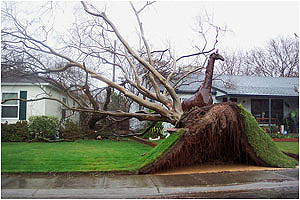Visual Tree Assessment
 Inspections
and surveys of trees include assessments of: health; condition; impact
of planned building work; visual amenity; hazard; risk management; damage
and damage risk predictions to buildings; routine woodland management;
and habitat for wildlife.
Inspections
and surveys of trees include assessments of: health; condition; impact
of planned building work; visual amenity; hazard; risk management; damage
and damage risk predictions to buildings; routine woodland management;
and habitat for wildlife.
The inspection process is not just restricted to the tree, a large amount
of supportive evidence can be found by observing the surrounding area
of the tree. This may include the past history of the area and the tree,
soil type, climate, and environmental conditions surrounding the tree.
New building construction, drainage of surrounding land, laying of patios,
removal of other trees, and alterations in land use can have an effect
on the tree’s condition.
Visual tree assessment has become the standard approach used for surveying
of trees. It is a common method used by means of visual examination
and documentation, together with the knowledge of tree biology and structure
to draw conclusions about tree condition. It is also a systematic approach,
which directs the tree surveyor through a procedure from biological
and routine observations through analysis, using understanding of failure
criteria.
In any inspection regarding tree health or safety, the surveyor will
look at each tree layer for biological signs including  undersized
leaves, discoloured foliage, dead branches, large or numerous cankers,
and fungal fruiting bodies. The surveyor will be able to recognize the
significance of these observations by comparing them with the typical
growth patterns and appearance of the tree involved. They will also
look at the tree for signs of structural weakness or for a change in
growth patterns that may indicate the tree has defects.
undersized
leaves, discoloured foliage, dead branches, large or numerous cankers,
and fungal fruiting bodies. The surveyor will be able to recognize the
significance of these observations by comparing them with the typical
growth patterns and appearance of the tree involved. They will also
look at the tree for signs of structural weakness or for a change in
growth patterns that may indicate the tree has defects.
If mechanical weakness is suspected, there may be a need for more investigation
using specialist decay detection and measuring equipment.
